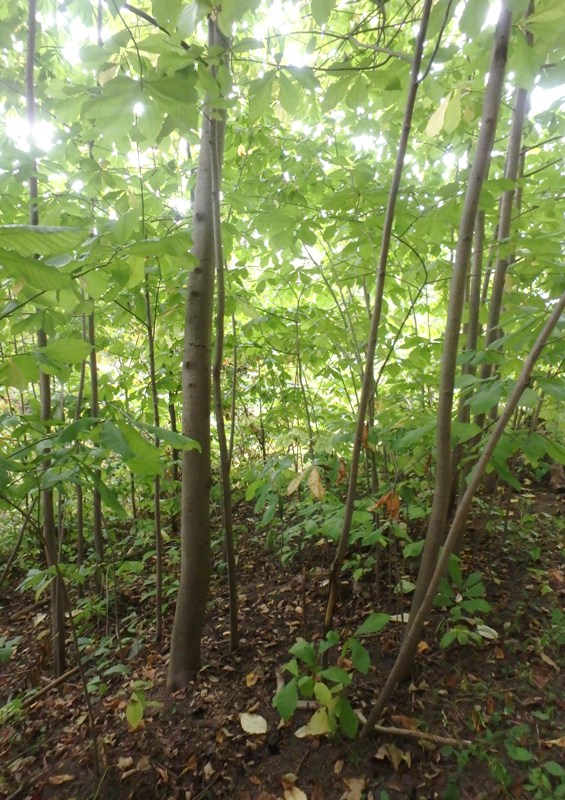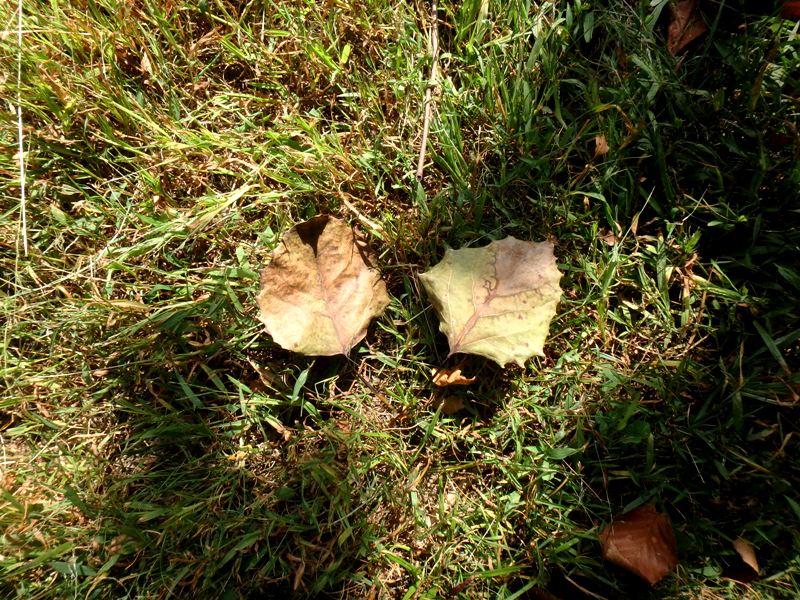Mariton: Aspen Clones
by Tim Burris, Preserve Manager

A Pawpaw clone.
A few weeks ago I mentioned in a Field Note that Pawpaws (Asimina triloba) are a clonal species. They have a “parent” tree whose roots range outward and send up shoots of new trees of all sizes. In the above photo, the largest tree is the parent. You will notice small shoots on the ground, as well as saplings a couple inches in diameter. Since these are all connected to the original tree, everything has the same DNA, or a clone of the parent tree. Pawpaw clones (groves, colonies or whatever you call them) are usually quite dense.

Bigtooth Aspen leaves.
Another group of trees that clone are the aspens. I grew up knowing these trees as poplars. “Popples” was the term Grandpa used on our tramps in the woods. [What we call Yellow Poplar (Lireodendron tulipifera) is actually in the magnolia family and not a poplar at all.] The Poplar Family consists of the cottonwoods, aspens and balsam poplars. Quaking Aspen (Populus tremuloides) and Bigtooth Aspen (Populus grandidentata) are early successional species that colonize disturbed areas and poor soils through clonal action. Though we are on the southern fringe of their range, there are Bigtooth Aspens at Mariton.
Quaking Aspen holds a special place in my heart. We had groves of them on my parents’ property growing up. Their bark has a wonderful texture and color. The name comes from the way the leaves tremble or quake. These trees are ubiquitous in our impressions of the Rockies, but also are important part of the ecology of the Northern U.S. and Southern Canada. As a kid riding to my grandparents’ cottage, I knew we were “Up North” as soon as I saw the poplars become the dominate tree alongside the highway.
Another reason I love Quaking Aspen is that in college I worked for my favorite professor collecting and analyzing samples for her research on Quaking Aspens. During the research, I could recognize an Aspen clone at long distances. You learn to recongnize the “dome” shape of a clone. Like most clones in open areas, the parent tree is the tallest and in the center, and each year new shoots pop out around the edge. This gives the clone a dome or umbrella shape.
Aspens, like pawpaws, have weak wood, so clones can keep the genes alive when the top of a tree is broken off by a storm. But female aspens also produce millions of seeds carried by the wind. All the trees in a clone will be the same sex. Quaking Aspen is really good at growing in poor soils. Ecologically, most clones help stabilize and improve the soil for the next class of trees. Aspen clones can have a big impact on their environment. They are also an important food source for wildlife like beavers, grouse, deer, elk and others.
Humans take advantage of clones too. Aspens grow quickly and are used for pulp and other wood products. So, you can harvest the wood from a clone in the winter, when all the energy is stored in the roots. The Aspen clone will grow back densely and be ready to harvest again in 20 years. The important thing for aspens is sunlight. Aspens need lots of light. When there are no disturbances like fire or storm, then other tree species will take advantage or the soil improvements that the aspens have made. Eventually these new trees will shade out the aspens and the forest will change again.
